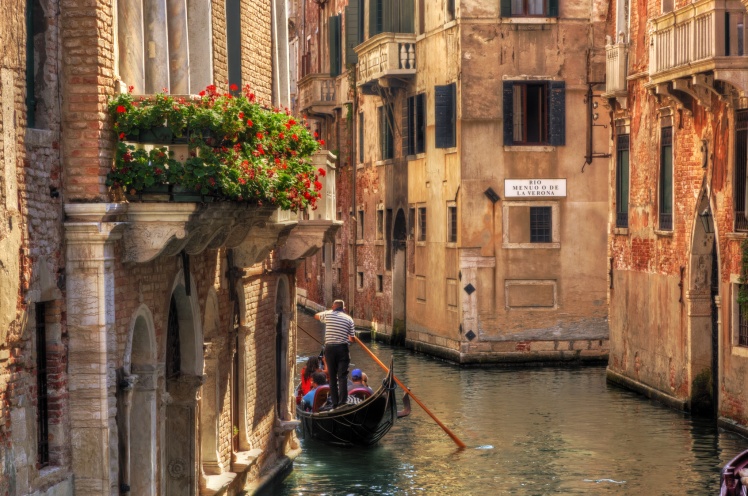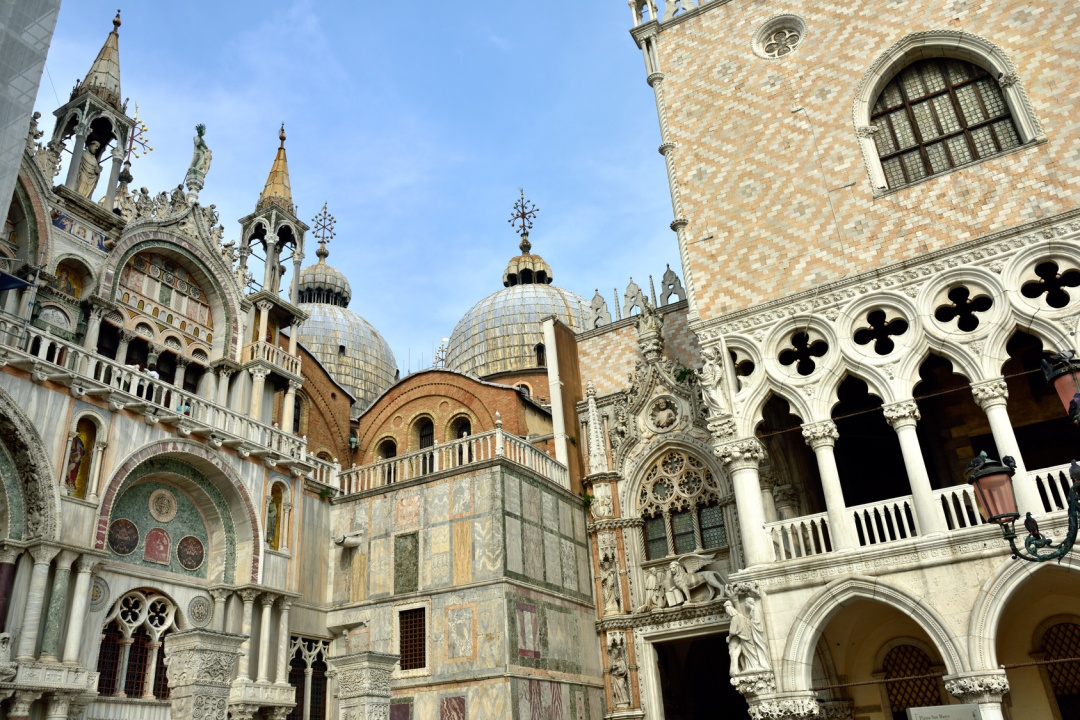Venice, also known as ‘The Floating City’ is a place filled to the brim with romance, mystery and has been a literary inspiration for centuries. Here’s a guide to how I explored and experienced the beguiling city of masks.

Rumour has it that Venice is sinking, but little do travellers know that it has always been sinking. Over one hundred islands are held up on beams deep in the water, raising the marshy ground above to create Venice. It was artificially constructed as a city of mystery and intrigue away from the mainland region of Veneto, and to this day the streets and canals of Venice are roamed by tourists, locals and fairytale characters. Between February and March last year, the city played host to the yearly festival, Carnivale Di Venezia, where the masquerade masks in the many boutiques come in handy. The theme for this year was a fairytale and the characters you’ve read about since childhood came alive on the Rialto Bridge and St Mark’s Square.
Transportation in this historical city relies mainly on water or on foot. There are more than three hundred bridges connecting the small islands of Venice and from Marghera and Mestre, you can take a short bus to the main bridge entering into Venice. Over the years, a railway station has been built so you can travel from Rome and Milan straight into Venice along with flying into Marco Polo International Airport. The easiest and most convenient way to get around within the secret city is by water ferry, gondola and on foot.
If you’re staying in the four-star Hotel Canal Grande, it’s a short water taxi from the main land and ease of access if you have luggage. The hotel is less than a minute’s walk from the Grand Canal Bridge and is located directly opposite its namesake. To experience the whole of the Veneto region you can stay at the four-star Hotel Delfino in Mestre, located on Corso del Popolo, which is a ten-minute bus from the bridges entering Venice. You can buy bus tickets from the hotel reception and walk across the road to catch the number 4L bus towards the ferovia (station). Remember to wear your comfortable footwear as Venice is one of Europe’s rare automobile-free cities. When purchasing tickets just say posso avere un biglietto, per favore? For two tickets you will say due biglietti and so on.
Venice harbours Italy’s clear and fresh water as its shallow lagoon constantly mixes with the Adriatic sea. Contrary to popular belief, Venice does not smell as if it’s settled on sewers – it smells like the sea and lagoon that surround it. The sewage system does not run into the lagoon and the constant flow of the Adriatic helps to clear old water. As Venice floods one out of every three days, the leftover water may smell slightly but only adds to the Venetian city. Within the city lies history and decay adding to the beauty of Venice and the magnificence of its art and architecture.

Piazza San Marco (St Mark’s Square) once played host to writers and poets such as Ernest Hemingway and the lively square will easily inspire you. For a magical touch, visit Saint Mark’s Basilica (Basilica San Marco) where you can compare it to other cathedrals and Basilicas in Italy. The difference is in its décor; where the rest of Italy has frescoes to tell stories, St Mark’s has paintings in real gold and rich red – a costly colour showing the expanse of luxury adopted by venetians. There are red glass lanterns hanging from the ceiling, along with other priceless jewelled ornamentation from the 11th to the 13th Centuries. Photography is banned within so take a million pictures with your memory. Nearby is the Murano Glass Factory where you can witness a glassmaker create jugs and bowls using a furnace and such extraordinary methods that will leave you with your mouth gaping.
You can get something to eat from the dozens of pizzerias, especially on the street leading away from the glass factory. Italy is known for its cuisine and there’s nothing better than taking a stroll over bridges and around the lagoon with a slice of Prosciutto Cotto con Mais (ham and sweetcorn pizza). Italy also has world renowned bars that serve on-the-go shots of coffee. For a shot and a bite of something sweet (imagine an endless selection of pastries) you can go to Torrefazione Marchi on Rio Tera San Leonardo, Cannaregio.
From Piazza San Marco find your way to the romantic Rialto Bridge by going through an archway and following the winding streets, paying close attention to the signs pointing you to Rialto. If you’re worried about getting lost on your way then waterbus number one goes around Canal Grande for St Mark’s. To find your way around on-foot, follow signs ‘Per Rialto’ and ‘Per S. Marco’, and to get out of Venice follow signs for ‘Roma Sq.’ and ‘Ferrovia’. Once you find Rialto Bridge you can take a gondola ride around the Canal Grande. Most Gondolas are €60 and accommodate six people (sharing will also drive down the price per person. Most gondola are decorated with velvet seats and pretty Persian rugs, giving you a taste of luxury while gliding through the maze of canals.

Once you finish your gondola ride and walk over the Rialto Bridge, you will notice a nest of locks upon an iron railing where lovers from years back have come and solidified their love and relationship on the famous bridge. Venice is known as one of the world’s most romantic and alluring cities and this has especially been depicted in literature and films. It was popular in Shakespeare’s Merchant of Venice and Othello as well as Thomas Mann’s novella, Death in Venice. Venice plays temporary host in the James Bond series and 2010’s The Tourist starring Angelina Jolie and Johnny Depp. The depth of literature inspired by the city is striking and helps lure you into its mesmerizing presence. Its striking landscape, architecture and culture have also led to the development of many nicknames, such as City of Canals, The Floating City and Queen of the Adriatic.
This tranquil city of masks has been given its individuality through diverse architectural style that is always being adapted. The most popular of which is Gothic, originating in 14th century Venice, yet when combining Renaissance, Baroque and Gothic styles, the deep history and culture of Venice truly comes alive. If it was not for the floods, the canals, bridges and interwoven styles, Venice wouldn’t be the place of beckoning mystery that it is today.
Venice by day and Venice by night are two completely different places, and you need to experience both. Stand alone on the Canal Grande Bridge at night and experience serenity settle over the floating city.




No Comments